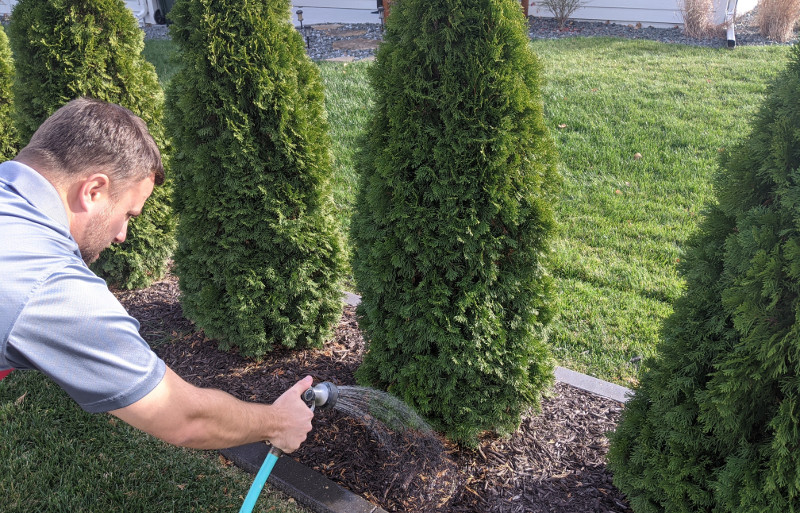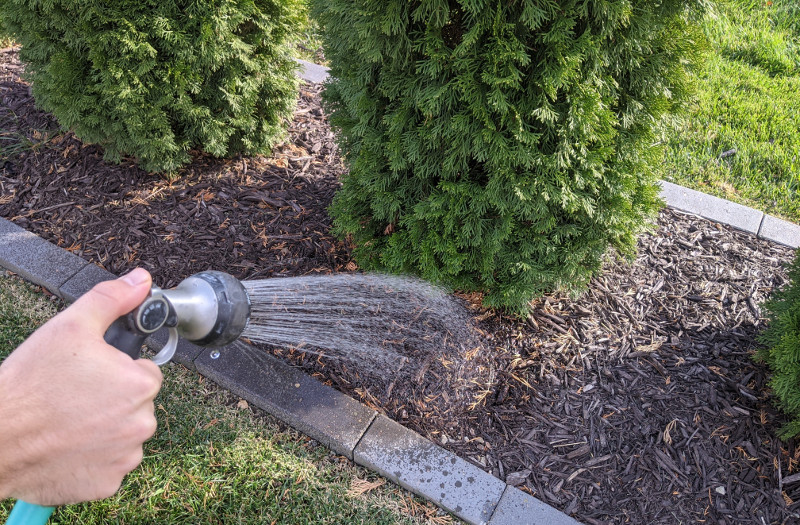Arborvitae are lush evergreen shrubs and trees whose relatively fast growth and low maintenance makes them really a popular choice for privacy screening or hedging. The key to remember is that while they are drought-tolerant once established, it’s important to provide consistent water for the first two growing seasons in its new site – more if it’s a large specimen, say over four feet tall at planting. This will help it thrive through transplanting shock and stay strong as its roots extend into the surrounding soil, develop a lush root system, and begin to grow into the showpiece you want for your garden.

How To Tell If Arborvitae Needs To Be Watered
You may notice some browning on the leaves of your arborvitae. The main question to ask is, is the browning on interior leaves only during the fall? That would be a normal part of the aging process. If foliage on the exterior of the plant is yellowing or browning – also called “Flagging” –
This could be a sign of drought stress. You might be surprised to learn that heat or drought stress can show up even one or two seasons after a drought event.
Other signs of thirst to watch for include overall weakness or needle drop beyond the normal interior needle browning/dropping in autumn.
Arborvitae like both regular moisture along with nice drainage in the soil. Confusingly, overwatering or poorly drained soil causes some of the same physical symptoms – foliage turning yellow or brown and/or dieback, especially on the exterior of the plant and the tips of the foliage.
Get in the habit of being proactive by checking the soil around new plantings for the first two seasons to see if it’s dry. Pale, gray or light brown soil with a hard, cracked appearance is a sign, but even if things look fine on the surface, dig down five inches and see if your watering is reaching the roots.

How Often To Water Arborvitae
Watering New Arborvitae
Before planting, soak the plant and water the planting hole too. Once planted, you want to first give the arborvitae a deep, thorough drink that saturates the roots and gets rid of any air pockets in the planting hole. Then, for the next two seasons, or longer for really large specimens, offer a weekly soak at minimum. Long, slow soaks that completely penetrate the root ball and surroundings are preferred over regular splashes with a watering can, which tend to only reach the top one or two inches. Plants in containers or in very sandy or rocky soil might need watering every day, possibly twice during excessive heat.
Watering Mature Arborvitae
Once your arborvitae has grown into its new home, which can take two years or more for mature trees, it will be able to go longer without water. However, it prefers regular moisture, and a two-week heatwave could dry it out quickly, so mulching and a watering system are helpful if you travel during warm weather. Overly dry conditions can draw spider mites to arborvitae, which is another reason to keep watering consistent. Weekly watering is recommended in well-drained soil.
Arborvitae in pots may need watering one-to-two times daily in very hot or dry conditions, especially in the first two years after planting. The larger the pot, the more leeway you have in watering. The best thing to do is to let the conditions determine your schedule rather than the other way around. Check down a couple of inches into the soil and test the moisture – if it is dry, water immediately. Established plants should be watered twice a week minimum depending on the weather, and whether it is in full sun or partial shade. Mulching will preserve moisture in the soil and keep it from drying out so quickly.
Best Time to Water Arborvitae
Mornings are a great time to water arborvitae, but if the soil is dry a few inches down, water right away, no matter the time of day.
In winter, be aware of weather conditions. Mulch if your conditions tend to be dry or exceptionally cold. Watering well before an expected freeze will help protect your plant’s roots and stems. A blanket of snow will insulate the soil as long as it persists. Containers should be consistently moist, but never soggy.
In mild wet climates, potted arborvitae may benefit from being moved under eaves, or have the roots protected by fern boughs or being mulched with pebbles.
How to Water Arborvitae?
Step 1 – Test the soil moisture with your finger or a trowel.
If the first inch or two of soil is dry, water immediately, regardless of time of day.
Step 2 – Water slowly and deeply
Using a hand-held hose, leave the hose on the plant on a slow trickle, moving it to get the whole circumference of the roots. Water for about a minute. Repeat until the soil is wet five inches down. Or, using a soaker hose, surround plant roots (in clay soil, move out from the dripline of the plant to prevent rotting the roots) and set it to drip and leave on for at least 15-30 minutes.
Arborvitae Watering Tips
- Arborvitae like that “just right” sweet spot of slightly moist all the time. Long soaks are best.
- Don’t let the soil dry out. Consider mulching.
- Make sure the soil has good drainage
- Exterior foliage yellowing could be a watering issue, even years after a stress. Interior browning and needle drop in fall is normal.
 |
Author Erica Browne Grivas - Published 10-07-2021 |
